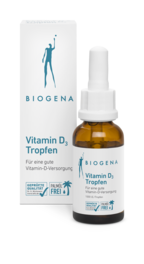Sunlight that tickles our nose not only warms our hearts, but is also the key to a vital nutrient - vitamin D. Paradoxically, despite seemingly adequate sunlight, up to 57 per cent of adults suffer from a vitamin D deficiency - a silent health risk that often goes unnoticed but can have far-reaching consequences.
The causes of vitamin D deficiency: How vitamin D deficiency develops
Vitamin D nimmt eine Sonderstellung unter den Vitaminen ein, denn sein Hauptbedarf wird nicht wie sonst üblich über die Ernährung abgedeckt, sondern von unserem Körper in Eigenregie durch Sonnenlicht selbst gebildet. 80–90 % des Bedarfs an Vitamin D können dabei mithilfe des Sonnenlichts vom Körper selbst gedeckt werden – soweit die Theorie. Doch in der Praxis stellen sich einer ausreichenden Vitamin D-Bildung etliche Störfaktoren in den Weg. So kann unser modernes Leben, das sich vorwiegend in Innenräumen abspielt, einer ausreichenden Vitamin-D-Versorgung behindern. Doch auch andere Faktoren beeinflussen die Vitamin-D-Bildung im Körper.
Anfällige Vitamin-D-Synthese & mögliche Einflussfaktoren:
- Zu wenig Sonnenexposition
- Zu geringer Einfallswinkel bzw. Intensität der Sonne
- Starke Bewölkung
- Fensterscheiben
- Dunkler Teint
- Bedeckte Haut
- Sonnenschutzmittel mit hohem Sonnenschutzfaktor (>20)
- Fortgeschrittenes Alter
- Kälte
- Erhöhter Bedarf
- Nierenleiden
- Verdauungsstörungen
Zu wenig Sonnenexposition
Besonders betroffen von schlecht gefüllten Vitamin-D-Speichern sind – wie bereits erwähnt – Personen mit niedriger oder fehlender Sonnenexposition, zum Beispiel wegen eingeschränkter Mobilität oder Bettlägerigkeit; aber auch schulpflichtige Kinder oder im Schichtbetrieb beschäftigte Menschen dürfen hier nicht vergessen werden – all jene Personen verbringen meist den Großteil des Tages in geschlossenen Räumen.
Aus diesem Grund empfehlen Expertinnen und Experten beispielsweise Schüler:innen oder „Büromenschen“, die Mittagspause zu nutzen, um an möglichst vielen Sonnentagen mindestens 15 min ins Freie zu gehen (ohne Sonnenschutz + unbedeckten Gesicht, Hals und Hände). Doch Frischluft ist noch lange kein Garant für eine ausreichende Vitamin-D-Bildung.
Einfallswinkel & Intensität der Sonne
Zudem ist die Eigenproduktion von Sonnenstand bzw. Einfallswinkel der Sonnenstrahlen abhängig: Nur wenn der UV-B-Index einen Wert von mehr als 3 erreicht, was einer UV-B-Strahlung von 290 bis 315 nm entspricht, ist das Sonnenlicht stark genug.
A simple rule for judging whether the intensity of solar radiation is sufficient for the body to synthesise its own vitamin D is to compare the shadow with the body length: if the shadow is longer than you are, the intensity of the radiation is too low. Accordingly, the body's own vitamin D synthesis almost comes to a complete standstill in our latitudes between October and March; and the radiation is also insufficient in the morning and evening hours.
Dark complexion
People with darker skin can also be affected, as a high melanin content in the skin slows down the formation of vitamin D.
Age
With age, the human body's own synthesis of vitamin D decreases by up to 50 per cent, which is why people over 65 should pay particular attention to maintaining stable vitamin D levels.
Cold & Sun Protection
Furthermore, cold weather or the use of high-protection sunscreen influence the formation of vitamin D in the body.
It was also previously assumed that the body's own production was almost completely switched off by skin creams, make-up or sunscreen with a sun protection factor of over 8. More recent data show that vitamin D is produced in sufficient quantities when sunscreen products with moderate sun protection factors of up to 20 are used. However, a restriction of vitamin D production can be assumed at very high sun protection factors above 20, as they are particularly recommended for children or during summer holidays when there is high solar radiation.
Pregnancy, breastfeeding & babies: Vitamin d deficiency when pregnant
Pregnant and breastfeeding women also have an increased need, as do infants in their first year of life, who must be protected from direct sunlight.
Want to know more about this topic? Click here for the articles:
Mission Impossible: meeting vitamin D needs through food
In addition to being produced by the body, vitamin D can also be ingested through food. However, nutrition experts in Germany, Austria and Switzerland agree that it is almost impossible to meet requirements purely through normal nutrition. The Austrian Nutrition Report also states that liver and fatty fish such as salmon, sardines, eel and herring contain significant concentrations of vitamin D, but are not on the menu every day and not in large quantities. More popular sources of vitamin D, such as egg yolk, milk and dairy products, on the other hand, only contain very limited amounts of vitamin D and are therefore unsuitable for meeting daily requirements. Especially with little or no personal production, the diet is not sufficient to achieve the target reference value of at least 800 I.U. (international units).


Vitamin D deficiency symptoms and consequences: what vitamin D deficiency can cause
Countless scientific findings in the last two decades suggest that vitamin D plays an important preventive role in maintaining the health of the entire organism. The potential symptoms and consequences of a vitamin D deficiency are accordingly far-reaching.
How does vitamin D deficiency manifest itself? Possible effects at a glance:
- Head & nerves: irritability, restlessness, migraines, ringing in the ears
- Hair: hair loss
- Immune system: susceptibility to infections, autoimmune reactions, allergies, increased risk of cancer
- Muscles: muscle weakness, muscle pain, limb pain, muscle cramps
- Bones: Impaired bone mineralisation (children: rickets, adults: osteomalacia), calcium deficiency, bone pain and deformation, bone fractures
- Metabolism: Increased risk of diabetes, increased risk of high blood pressure
The dark season – when infections flourish.
Winter is peak season for flu-like infections and colds. Doctors and researchers have long suspected that this annual ‘wave of illness’ is at least favoured by low vitamin D levels. Not least, vitamin D activates both antiviral and antibacterial proteins and also influences other immune processes. A vitamin D deficiency, on the other hand, can sap the immune system's ability to function. So there is a lot to suggest a connection between vitamin D and respiratory diseases – and an increasing number of studies. For example, an Austrian study revealed a link between the frequency of infection and illness among employees and their poor or sub-optimal vitamin D levels.
Risk target group for vitamin D deficiency
The Robert Koch Institute estimates that blood vitamin D levels are deficient in more than 57% of adults. The situation is even more precarious among the older population. Many older people spend less time outdoors due to health reasons or limited mobility. In addition, skin becomes thinner with age, greatly reducing the ability to produce vitamin D naturally.
Further risk groups for vitamin D deficiency:
- People with little or no exposure to the sun
- Shift workers
- Older people
- Infants and toddlers, as well as growing children
- Pregnant and breastfeeding women
- People who always wear long clothing
- Dark-skinned people
- Smokers
Vitamin D deficiency in children
A child's body is constantly growing and changing. This makes it all the more important to supply adolescents with sufficient micronutrients. As a regulator of calcium and phosphate metabolism, vitamin D has a decisive influence on the strength of the bones. If there is a deficiency, the bones are unable to incorporate minerals into the bone substance. As a result, the bones remain soft and become deformed. Doctors speak of rickets.
To keep the risk of rickets in check, babies should have any potential vitamin D deficiency averted: breast milk contains insufficient amounts of vitamin D, and the vitamin D content of bottle-feeding is also insufficient. At the same time, babies' sensitive skin should not be exposed to direct sunlight. That is why babies are recommended to take a preventive vitamin D supplement (400–500 I.U.). According to the German Society for Paediatrics and Adolescent Medicine (DGKJ), this recommendation applies until the child experiences their second early summer.
But what about older children? Their vitamin D levels are anything but optimal – and this in a developmental phase that is important for bone formation and growth. A study by the German Robert Koch Institute (KiGGS study) found that 62% of boys and 64% of girls between the ages of 3 and 17 had low blood vitamin D levels (< 50 nmol/L).
Vitamin D deficiency symptoms in children
While rickets only rarely occur with the recommended vitamin D supplementation (from the first week of life until the second experienced early summer), other childhood signs of vitamin D deficiency are not particularly specific. The following symptoms may indicate a vitamin D deficiency in children:
Increased susceptibility to infection
Pronounced tiredness & fatigue
Poor performance
Restlessness
Sleep disorders
Increased sweating
Measure & diagnose vitamin D deficiency
Vitamin D is the only vitamin that is not obtained from food but primarily from the sun. And yet studies repeatedly show that the vitamin D stores of many Europeans are depleted. Many people are probably wondering what their own vitamin D levels are.
How can vitamin D deficiency be detected?
A vitamin D test is a simple way to shed light on the subject. To determine vitamin D levels, the blood vitamin D level is measured as 25-hydroxyvitamin D3 and, depending on the laboratory, is given either as nmol/l or as ng/ml. (To convert nmol/l to ng/ml, simply divide the nmol/l value by 2.5.)
Values – from which point should you be worrying about a vitamin D deficiency?
From 75 nmol/l or 30 ng/ml, it is considered a mild vitamin D deficiency. At less than 50 nmol/l or 20 ng/ml, it is considered a severe vitamin D deficiency. Here is an overview of all the values:
|
Assessment of the status |
25 hydroxy vitamin D serum level (nmol/l)) |
25 hydroxy vitamin D serum level (ng/ml) (-> equivalent to "μgl/l") |
|
Serious deficiency |
< 50 nmol/L |
< 20 ng/ml |
|
Slight deficiency |
50 - 75 nmol/L |
20 - 30 ng/ml |
|
Sufficient supply |
75 - 100 nmol/L |
30 - 40 ng/ml |
|
Optimal supply |
100 - 150 nmol/L |
40 - 60 ng/ml |
Table: Assessment of vitamin D status
Treatment for deficiency of vitamin D - or better yet, how to avoid it
Long-term vitamin D deficiency can have a variety of consequences, some of which are serious. This makes it all the more important to take targeted action against a vitamin D deficiency, or ideally to avoid it altogether.
What can be done about it?
To quickly remedy a vitamin D deficiency, it is recommended to take a vitamin D supplement under a doctor's supervision to specifically improve vitamin D intake. The chosen dosage should be based on the respective body weight. Online vitamin D calculators can help you choose the right dosage and the desired dosing period. Due to the health benefits, the aim should be not just an adequate vitamin D supply, but an optimal one.
How long does it take to recover from vitamin D deficiency?
How long it takes to rectify a vitamin D deficiency depends on various factors. These include, among other things, the extent of the deficiency, the dosage and the respective body weight. However, as a rule, it takes several weeks to months.
Conclusion
Vitamin D is a special vitamin because our bodies produce it through sunlight exposure, rather than through our diet as is usually the case. Nevertheless, for many people, diet and sun alone are not enough to ensure optimal vitamin D levels. In this case, it makes sense to supplement with a high-quality vitamin D supplement.
Sources:
Schoenmakers, I. et al. 2015. Prediction of winter vitamin D status and requirements in the UK population based on 25(OH) vitamin D half-life and dietary intake data. J Steroid Biochem Mol Biol. 1–5. https://pubmed.ncbi.nlm.nih.gov/26970588/
Holick, M. F. 2004. Sunlight and vitamin D for bone health and prevention of autoimmune diseases, cancers, and cardiovascular disease. Am J Clin Nutr. 80(6 Suppl):1678S-88S. https://pubmed.ncbi.nlm.nih.gov/15585788/
Wäger et al. 2022. BIOGENA Good Health Study: Vitamin D
Sinnißbichler, T., Viebahn, I. Vitamin D gesucht – Defizite gefunden. Biogena Studie 2011.
Gröber, U. Arzneimittel und Mikronährstoffe: Medikationsorientierte Supplementierung, 3. aktualisierte und erweiterte Auflage. Stuttgart: WVG Wissenschaftliche Verlagsgesellschaft Stuttgart, 2014.
Zhang, H. et al. 2014. Maternal vitamin D deficiency during pregnancy results in insulin resistance in rat offspring, which is associated with inflammation and Iκbα methylation. Diabetologia. 57:2165-2172.











